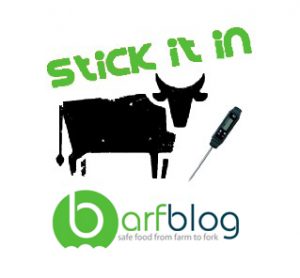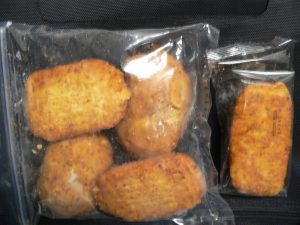In 1998, the U.S. Department of Agriculture very publicly began to urge consumers to use an accurate food thermometer when cooking ground beef patties because research demonstrated that the color of meat is not a reliable indicator of safety.
 USDA Under Secretary for Food Safety at the time, Catherine Woteki, said, “Consumers need to know that the only way to be sure a ground beef patty is cooked to a high enough temperature to destroy any harmful bacteria that may be present is to use a thermometer.”
USDA Under Secretary for Food Safety at the time, Catherine Woteki, said, “Consumers need to know that the only way to be sure a ground beef patty is cooked to a high enough temperature to destroy any harmful bacteria that may be present is to use a thermometer.”
At the time, I said, no one uses a meat thermometer to check the doneness of hamburgers. The idea of picking up a hamburger patty with tongs and inserting the thermometer in sideways was too much effort (others insist the best way to use a tip sensitive digital thermometer is to insert into the middle of the patty at a 45 degree angle).
I was wrong.
Shortly thereafter, I started doing it and discovered, not only was using a meat thermometer fairly easy, it made me a better cook. No more extra well-done burgers to ensure the bugs that would make me sick were gone. They tasted better.
By May 2000, USDA launched a national consumer campaign to promote the use of food thermometers in the home. The campaign featured an infantile mascot called Thermy that proclaimed, “It’s Safe to Bite When the Temperature is Right.”
Seventeen years later, the converts are minimal. Canada came to the thermometer table a few years ago, Australia is doing a slow policy creep, but the UK is still firmly committed to piping hot.
The UK Food Standards Agency recently published the sixth, chief scientific adviser’s Science Report, entitled Data Science. No mention of thermometers except to determine refrigerator temperatures or included as packing on food.
Science-based policy depends on whose science is being quoted to what ends. The fancy folks call it value judgments in risk assessments; Kevin Spacey in the TV series House of Cards would call it personal advancement.
So last week, when UK media reports dubbed Hepatitis E the Brexit virus, with the potential for 60,000 Brits to fall sick annually from EU pork, the UK Food Standards Agency once again reiterated how fucking unscientific they are.
 “Following media reports this morning we wanted to remind consumers of our advice about cooking pork thoroughly. We always advise that whole cuts of pork, pork products and offal should be thoroughly cooked until steaming hot throughout, the meat is no longer pink and juices run clear.”
“Following media reports this morning we wanted to remind consumers of our advice about cooking pork thoroughly. We always advise that whole cuts of pork, pork products and offal should be thoroughly cooked until steaming hot throughout, the meat is no longer pink and juices run clear.”
The National Pig Association — it’s a thing, “recommends that consumers follow the advice from the Food Standards Agency that pork and sausages should be cooked thoroughly until steaming hot throughout, with no pink or red in the centre, to greatly reduce the risk of infection.”
Back to science instead of a rainbow fairy tale on safe cooking procedures, in May 2011, USDA recommended pork, and all whole meat cuts, only have to get to 145 degrees internally, not the 160 the agency had previously suggested, followed by a 3-minute rest.
The U.S. pork board for years promoted pork be cooked with a “hint of pink.”
This has more to do with breeding efforts to produce leaner pork.
But HEV is a different beast.
Public Health England reported the number of severe cases has almost trebled since 2010, with 1,244 reported in 2016, compared with 368 six years earlier.
The virus causes a flu-like illness and in severe circumstances, could cause death.
This strain has been linked to pig farms in France, Holland, Germany and Denmark and is only killed in meat if people cook it for longer than usual.
Dr Harry Dalton, a gastroenterologist at Exeter University, told a conference on neurological infectious diseases HEV had become a major threat and that no one should eat pink pork and that pregnant women and transplant patients should not eat pork at all.
He also said the virus is heat resistant and survives being cooked until the meat is heated to above 71C (160F) for two minutes.
Looks like some research is required, not that the Brits would change their no pink policy. Maybe they’re homophoblic.
With Memorial Day on Monday in the U.S. and a bank holiday Monday in the U.K., whatever that is, USDA yesterday once again stated, “The best and only way to make sure bacteria have been killed and food is safe to eat is by cooking it to the correct internal temperature as measured by a food thermometer.”
Recent research by USDA and the Food and Drug Administration (FDA) found that only 34 percent of the public use a food thermometer when cooking hamburgers – and that’s self-reported, people lie on surveys.
Use a fucking thermometer and stick it in.
(If you don’t like profanity, don’t read, but if you want to read, your IT censors may figure you can’t handle such dreadful language, and messages are getting blocked. You may want to have a word with your IT folks.)
 Siofra Brennan of the Daily Mail writes people have been sharing images of their ‘juicy and tender’ meals of medium rare chicken, claiming it’s the best possible way to enjoy the meat, but their claims certainly haven’t gone down well with the masses.
Siofra Brennan of the Daily Mail writes people have been sharing images of their ‘juicy and tender’ meals of medium rare chicken, claiming it’s the best possible way to enjoy the meat, but their claims certainly haven’t gone down well with the masses.  While the post by Ms Gibbs was most likely a joke, the image itself was of a legitimate dish, origination from a blog promoting tourism in the Japanese region of Shizuoka and the recipe for chicken tataki; chicken seared over hot coals and served raw.
While the post by Ms Gibbs was most likely a joke, the image itself was of a legitimate dish, origination from a blog promoting tourism in the Japanese region of Shizuoka and the recipe for chicken tataki; chicken seared over hot coals and served raw.















